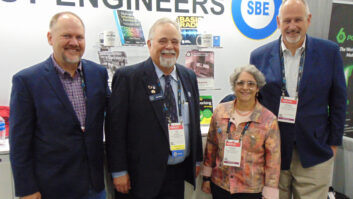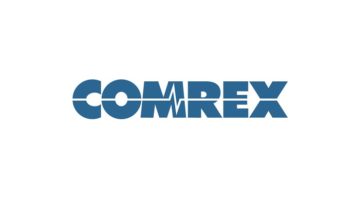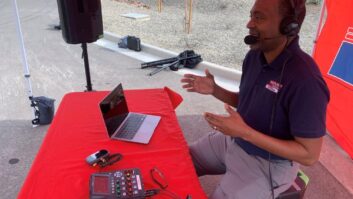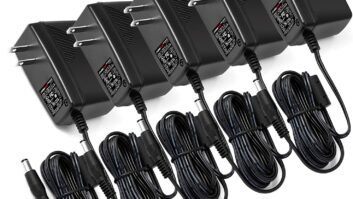WSUM, Madison, WI
Sep 9, 2002 12:00 PM, By Victoria Kipp, CSTE CBNT
WSUM, Madison, WI
History of Student Radio at University of Wisconsin-Madison
After a long history of short-lived campus radio stations and periods without any campus radio, the UW-Madison finally has a licensed student radio station. In the early 1990s, the UW-Madison, which is one of the largest universities in the world with an enrollment of 40,000 students, was without a student radio station. It hadn�t always been that way. In fact, between 1954 and 1993, UW-Madison had seen the rise and fall of five different stations: WMHA, WLHA, WSSO, WSRM, and WLHA.

The transmitter building and tower.
WMHA, the first UW-Madison student run station, was heard from 1954 to 1956. Its call letters came from its location in the mens lakeshore dormitories, and stood for Mens Hall Association. WMHA was fed to the lakeshore dormitories via carrier current. The AM RF signal was superimposed on the dormitory AC and fed through existing electrical wires to dorm rooms. The station went through three locations and four frequency changes before the FCC declared WMHA�s transmission wiring system illegal in 1956, and insisted on new wiring.
The STL transmit antenna.

1959 brought both change and stability to WMHA. It moved to a different address, changed its call letters to WLHA to acknowledge the new Lakeshore Hall Association governing body, and became established at AM 640. WLHA became more popular, was wired to more dormitory rooms, and grossed about $100,000/year in advertising during the 1960s.
Another dorm-based station called WSSO-AM was created to serve the Southeast area dorms. WSSO was soon renamed WSRM. Reception of WSRM�s carrier current signal was problematic. Reception quality was degraded by the operation of refrigerators, lights, and stereos in dorm rooms.
With a long-term vision of creating one campus wide radio station, WLHA and WSRM combined sales departments. Both stations struggled with declining audiences during the 1970s as AM lost popularity to FM radio. At the same time, advertising revenue softened. WSRM ended its run in 1981 due to dying equipment, waning interest and inadequate financial support.
From 1981 to 1984, a group called Students for Progressive Radio (SPR) labored to start a new FM student radio station. They had grand goals of mounting an antenna atop a campus hall, and broadcasting 100W of power to the Madison area. Unfortunately, they failed to get a FCC license, and their funding was subsequently discontinued.
The transmitter being readied for installation.

From 1987 to 1991, the Wisconsin Broadcast Communications Foundation (WBCF) wanted to create a new station to replace WLHA as the only all-campus radio station. WBCF was not able to get an FCC license due to issues with funding, timelines and relations with the student government.
In 1984, WLHA transitioned from an AM to an FM station, and transmitted 1.5W of power at 91.5MHz. WLHA-FM struggled with a limited audience, a weak signal, management disorganization and alienation from campus administration due to critical on-air comments about the UW Chancellor. The station had changed from being a lab activity for engineering students to an extracurricular activity for social science students. Through the 1980s, WLHA�s student management style was informal, and station policies were passed on by word-of-mouth instead of written documentation. The lack of continuity almost cost WLHA its funding in 1989. The station came within one vote of being eliminated from the Lakeshore Housing Authority budget.
Informal management of WLHA and staff attrition through graduation contributed to another problem: not having a FCC license. The staff erroneously believed that WLHA was exempt from license requirements because of its low-power output. Until it was confronted by the FCC, WLHA assumed that it did not need a broadcast license. Typically, the FCC only investigated unlicensed stations after receiving a complaint. They weren�t actively searching for non-compliance. Students at WLHA boosted the station�s power sometime between the late 1980s and early 1990s, and WLHA�s condition of being an unlicensed �pirate� radio station eventually caught up with it.
While the FCC never instructed WLHA to cease broadcasting, the management team decided to stop broadcasting and pursue a license in the correct manner to avoid future problems with the FCC in this respect. And so WLHA signed off of the airwaves for good.

One guy anchor.
As disappointing as the FCC shutdown of WLHA was, it was valuable because it pointed out the tenuous position WLHA was in. By being run as an amateur radio club under the auspices of the campus housing authority, rather than being run as an independent student organization, WLHA was not realizing its full potential.
From Radio Club to Radio Station
After WLHA shut down, it was initially hoped that the station would get licensed and resume broadcasting before long. WLHA wanted to come back as an all-campus station. When presented with the vision of turning WLHA into an all-campus radio station, the Lakeshore Housing Association decided that it was not appropriate to financially support or associate with the station. WLHA needed support from the UW-Madison and the University of Wisconsin system. In 1993, student radio at the UW-Madison gained two important allies: Dr. James Hoyt and Dave Black. Dr. Hoyt, who had been helpful to the many previous efforts to create a campus-wide radio station, would convince the UW-System Board of Regents to hold the FCC license for WLHA. Dave Black would become the general manager for WLHA, and lead the effort to get a FCC license, have engineering studies done, and present the WLHA initiative to the many officials and committees at the University.
In 1995, the UW-Madison student government approved WLHA�s startup budget. The station spent their budget conservatively, realizing that if the FCC didn�t approve their license application, their spending would be a waste. Station manager Dave Black expressed an obligation to the students of UW-Madison to spend the portion of their tuition money apportioned to WSUM frugally. To WSUM�s credit, the station spending generally comes in under budget. Whenever practical, WSUM buys used furniture and other items from the UW surplus shop. WSUM is furnished by mix and match used items, except in the studio. The studios have professional consoles and one �nice� chair per microphone. Another way WSUM saves money is by relying on volunteers to design and maintain their website. Only a few student management positions are paid. General Manager Dave Black would like to pay more student positions, and would like to raise the wage for the current paid positions, but must make sacrifices to stay within the budget.
After receiving budget approval from the UW-Madison, the station got the backing of the UW Board of Regents. WLHA abandoned their call letters and became known as UW-Madison Student Radio. In 1996, the station relocated to its present downtown Madison studio within “The Towers” apartment building at 602 State Street.

The Jampro FM transmit antenna.
Next, the station began seeking a location for their transmitter and antenna. They would have preferred to co-locate their antenna on an existing tower, but that wasn�t possible due to the tower location dictated by FCC rules. The station reached a tentative agreement to lease land on a family dairy farm in a nearby rural town. The FCC approved the station�s broadcast license application in October 1996. The station changed its call letters to WSUM. WSUM 91.7 FM planned to sign on the air in September 1997.
After securing approval from the UW-Madison and the UW-System, as well as funding from the student government, and a license from the FCC, WSUM�s biggest obstacle was getting zoning board approval of the proposed site for their 403-foot guyed tower in the rural town of Montrose.
WSUM could not have anticipated how much opposition their proposal would receive from some Montrose residents. Residents fought the tower because they considered it an eyesore, and feared it would lower their property values. The town raised concerns about the risk of falling ice or tower collapse. Montrose�s opposition to the tower led to a lengthy �Not In My Back Yard� (NIMBY) legal battle that began in February 1997 and continues to this day. Despite the intense local resistance against locating the tower in Montrose, relocating the tower was not an option because Montrose was the only place that WSUM�s transmit antenna could be located to broadcast a licensed signal to Madison without causing interference to existing radio stations.
When it became clear that the tower conflict would not be settled soon, WSUM began webcasting in September 1997.
In April 1998, the Dane County Zoning and Natural Resources Committee granted WSUM a Conditional Use Permit (CUP) for tower construction under a �governmental use� exception in the county ordinance. In July 1998, Montrose argued that student radio doesn�t qualify as governmental use, and successfully appealed to a Citizen�s Board appointed by the county executive. Although the town of Montrose was an advisory committee for zoning, the county had jurisdiction over the tower�s approval or rejection. In August 1999, 9th Circuit Court Judge Gerald Nichol overturned the Citizen Board�s decision. Montrose appealed Nichol�s judgment. The Wisconsin Court of Appeals agreed to hear Montrose�s �governmental use� appeal in January 2000 on an expedited schedule, and also freed up Montrose�s political appeal of the Zoning and Natural Resources decision to move forward. The county continued to hold the appeal in suspense by the process of complete, detailed, and unequivocal affirmation of the Circuit Court decision in August of 2000 and the Wisconsin Supreme Court�s decision to refuse to hear Montrose�s appeal of the Court of Appeals decision. At the April 2001 County Board meeting, the Board voted by a margin of 27 to 8 to let the Zoning and Natural Resources ruling stand, and issued a Conditional Use Permit to the UW for the WSUM tower. In July 2001, Montrose appealed to the County Board of Adjustment that WSUM�s original one year Conditional Use Permit that the County Zoning and Natural Resources Committee granted WSUM in April 1998 had expired during the extended legal battle over the tower. The Board of Adjustment rejected Montrose�s claim.

The antenna reflector.
Ultimately, WSUM�s tower application went through the court system twice: once for the issue of whether or not it was �governmental use� and once for the issue of how the tower conformed to zoning standards. After a four year legal battle, approval for WSUM�s tower zoning application was upheld by a court decision, and tower construction began in 2001. Although Montrose filed further legal action, tower construction moved forward.
During tower construction, the town of Montrose filed a restraining order against WSUM which was enforced from Friday to the following Tuesday. When a judge heard the disagreement between Montrose and WSUM, he ruled that Montrose didn�t have a strong enough chance of winning the overall court case to halt construction, and struck down the restraining order against WSUM.
WSUM�s legal representation did not affect their budget. The attorneys who represented WSUM are on salary for the UW-System. WSUM�s legal issues did not cost students and taxpayers extra money.
WSUM had begun webcasting in 1997, and terminated webcasting in 2002 shortly before they began broadcasting on the air. They ceased webcasting because they were not able to comply completely with the Digital Millennium Copyright Act (DMCA). WSUM is waiting to see if the US government will resolve issues about DMCA royalties and modify the rules.
Broadcast Transmission
Once tower construction moved forward, WSUM could build out their broadcast transmission system. WSUM�s program audio is microwaved over the 14-mile STL path. Their air-cooled 5,600-watt Harris Z5CD transmitter runs on single-phase power. A Burk GSC-3000 transmitter remote control unit allows remote access to transmitter logging and control. WSUM�s tower has the capacity to hold many cellular and PCS antennas, in addition to WSUM�s antenna. The circularly polarized Jampro antenna, with a parasitic metal reflector behind the driven element, transmits at 91.7 MHz. The highly directional WSUM transmit antenna doesn�t cause interference to other area radio stations. The antenna creates a single lobe pattern that is very tight at the antenna and broadens as it moves away from the tower, focusing on downtown Madison.
After a tenacious effort, WSUM began broadcasting right on schedule on at 2:22 PM on 2/22/2002.
Kipp is a broadcast engineer at the Educational Communications Board (ECB) public broadcasting network, Madison, WI.












